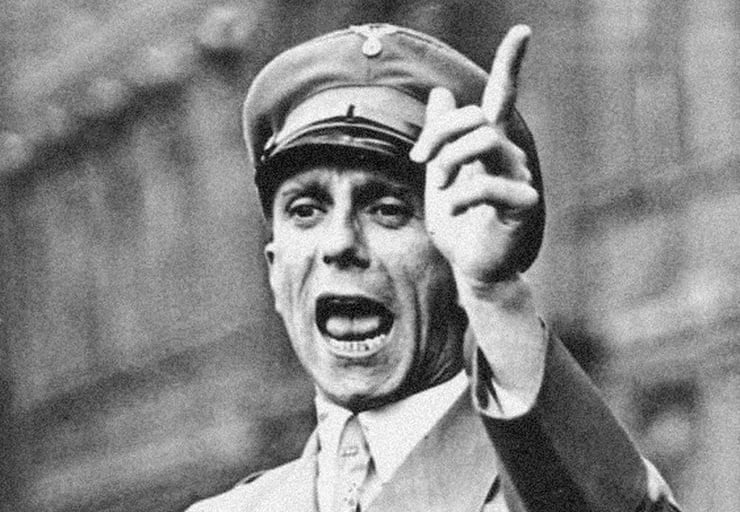The German Reich Minister of Propaganda is credited with a method according to which the media should provide 60% of information in the interests of the enemy and 40% of their own disinformation. We checked whether Goebbels actually came up with such tactics.
The principle that will be discussed has been mentioned quite often in Russian-language media in recent years. Here's what about him writes famous director and journalist of Radio Liberty Yuri Veksler:
“This method consists of creating media that provide 60% of their information in the interests of the enemy. But, having thus earned his trust, the remaining 40% are used for extremely effective disinformation thanks to this trust. During World War II, there was a radio station that the anti-fascist world listened to. She was believed to be British. And only after the war it became clear that in fact it was Goebbels’ radio station, operating according to the “40 to 60” principle he developed.”
A description of the method is also found in the 2016 book “The charm of totalitarianism. Totalitarian psychology in post-Soviet Russia", in an article from an overseas magazine American Thinker (though authored by a Russian-speaking journalist), in the online encyclopedia "Tradition" and many other places.
Most Russian references to “40 to 60” refer to the words of Vladimir Yakovlev, a famous Russian journalist and media manager, founder of the Kommersant newspaper and a popular online magazine "Snob". Here's the complete one text his articles, circulated not only by the media, but also by dozens, if not hundreds of reposts on social networks. In his entry, Yakovlev talks about five methods of propaganda (“rotten herring”, “inverted pyramid”, “big lie”, “40 to 60”, “absolute obviousness”), which he studied at the military department of the Faculty of Journalism of Moscow State University in a “top secret” environment. Yakovlev mentions Goebbels only in connection with one technology (“40 to 60”), and at the end he notes that he could continue the list - the training lasted a whole year, and the list of methods is quite large.
This article was first published on the Mulbabar resource at sguschenka.squarespace.com. At the beginning of 2014, Yakovlev emigrated from Russia to Israel, and a year later announced about raising $50,000 to launch “Media that can stop the escalation of hate” on the crowdfunding site Kickstarter. As follows from the project data on the website, it was supported by about 500 people. And already in mid-May 2015, the first signs of “Mulbabar” appeared: Yakovlev’s column on propaganda methods, an interview with Boris Grebenshchikov, an essay about Lev Zilber and other texts. Yakovlev called the main goal of his project, which did not last long, to turn “madmen back into people.” By “madmen,” Yakovlev meant precisely the victims of state propaganda. This resource is not available today.
It is important to note that before Yakovlev’s article there are no traces of any mention of the “40 to 60” method (with or without Goebbels) in the Russian-language segment of the Internet. A search in English in sources before 2015 also leads to nothing, except that as compensation you can find out about popular method of the same name making coffee. But what about Goebbels? Was there something similar in his arsenal?
Of course, propaganda, particularly through the use of radio, was a very effective tool during World War II. Both sides used a large arsenal of means for the purposes of propaganda and disinformation. The name of William Joyce, a Briton who spent five and a half years reporting from Hamburg about the victories of Nazi troops, is shrouded in an aura of dubious glory. By according to the BBC, his programs were regularly listened to by 9 million Britons, or 30% of the adult population. But Joyce and his radio station did not pretend to be the enemy: “Germany speaking, Germany speaking. Reich radio broadcasts from Hamburg via a transmitter in Bremen and a DXB transmitter. Next you will hear the news in English.”
Sefton Delmer, a native of Berlin, who from 1941 to 1945 headed several German-language propaganda radio stations broadcasting from Britain, acted somewhat closer to the principle described by Yakovlev. Before the war, Adolf Hitler once spoke of Delmer as his favorite foreign journalist, which did not prevent the latter from falling under British recruitment in September 1940. The concept of the broadcasts of the network organized by Delmer was to undermine in every possible way the authority of Hitler and the NSDAP, formally masquerading as ardent supporters of Nazism. Patriotic pathos alternated with disinformation, so skillfully that Joseph Goebbels himself in November 1943 admiringly wrote in in your diary:
“The station does a very clever piece of propaganda work, and from what is broadcast, one can conclude that the British know exactly what they have destroyed [with their bombing] in Berlin and what they have not.”
Of course, German propagandists also used similar rather obvious techniques (avoiding absolute lies, as well as absolute truth), but there is no information that Joseph Goebbels was a theoretician of such tactics (much less chose the 60:40 ratio). Historical papers, his diaries and books on the theory of disinformation are silent about this.
Thus, the “40 to 60” method is the invention of either Vladimir Yakovlev himself, or the compilers of the “textbook with a blue smeared special unit stamp,” which he wrote about in his sensational publication, or one of their predecessors.
Fake
Read on topic:
1. The Fake British Radio Show That Helped Defeat the Nazis
2. Leonard. W. Doob. Goebbels' Principles of Propaganda
3. Five methods of propaganda in the Russian Federation
If you find a spelling or grammatical error, please let us know by highlighting the error text and clicking Ctrl+Enter.







